A Private Tour today. One request was to see Dartford Warblers, but the forecast was for rain early morning and brighter conditions later. So, after a slightly later than usual start to let the rain clear, we popped along to Cley to see what else was about first.
Our first stop was in Teal Hide. There is a lot of mud now on Pat’s Pool and a nice selection of waders to take advantage. One of the first birds we saw was a very smart summer plumage Spotted Redshank – still largely jet black with silver spangling on the upperparts. Clearly a new arrival, as they quickly moult into silvery grey winter plumage here. Unfortunately, another request for today was photography and the Spotted Redshank remained a little distant for the cameras, in the deeper water area of the scrape. A cracking bird nonetheless and good views through the scope.
 Spotted Redshank – still in almost full summer plumage
Spotted Redshank – still in almost full summer plumage
A nervous flock of Dunlin kept wheeling round and landing back in the shallows on the far side of the island. Numbers of Dunlin are steadily increasing now and we counted over 120 in this group. Most were adult birds still sporting their summer black bellies but a small number of juveniles were in with them. A single Golden Plover, still in summer plumage too, was preening at the back of the main island. A couple of Lapwings were feeding on the mud close by.
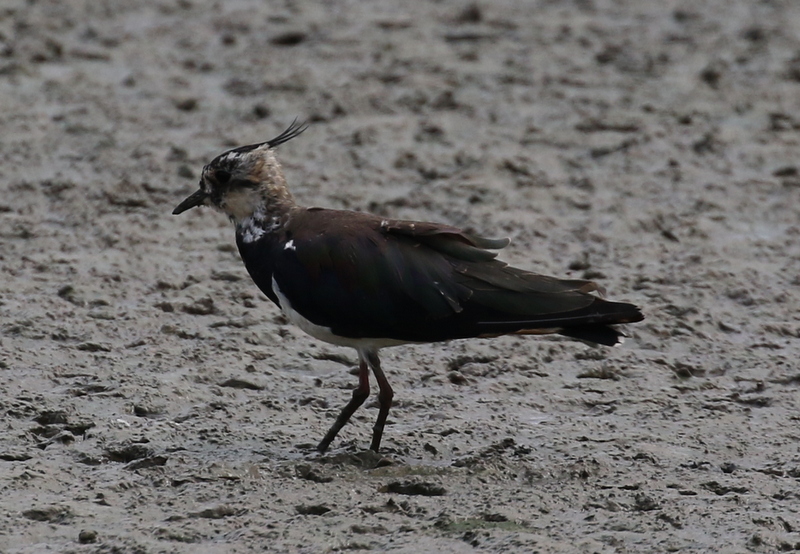 Lapwing – also taking advantage of the mud
Lapwing – also taking advantage of the mud
From Dauke’s Hide, we got better views of Black-tailed Godwit and Ruff, roosting on the first island. Otherwise the water level here is a little high for waders now. The Ruff are still in various states of moult but most are already in winter plumage. In contrast, there are still some very smart orange Black-tailed Godwits here.
 Black-tailed Godwits & Ruff – roosting on Simmond’s Scrape
Black-tailed Godwits & Ruff – roosting on Simmond’s Scrape
Tipped off about a Green Sandpiper, we had a quick look at the normally quiet Whitwell Scrape. As well as the Green Sandpiper, we found a single Snipe on here today, but both were a little too far off for photography today.
We walked back towards the visitor centre and round to Bishop Hide next. As the water level on Pat’s Pool has dropped, the mud right in front of the hide here has started to dry out so again the birds were not as close as they can sometimes be. Still there were more waders to see here. A single Common Sandpiper was working its way unobtrusively round the edge of one of the islands. Several Little Ringed Plovers were running round on the drier mud and hiding among the lumps – two adults with black-striped faces and a browner-headed juvenile. A large number of Avocets were sleeping on one of the islands out in the middle, mostly out of view, but two adults were chasing a fully grown juvenile around in front of the hide.
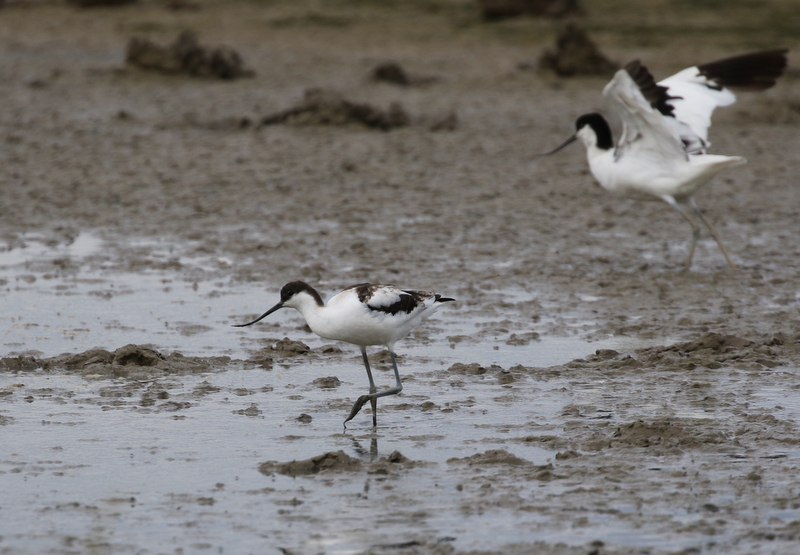 Avocets – more argy bargy today
Avocets – more argy bargy today
After a drive round to the beach car park, we walked out towards North Hide. Three adult Gannets flew past over the sea in the fresh northerly wind an several Sandwich Terns were fishing offshore. On the small pool by the fence, we stopped to admire a Little Ringed Plover. At that point a Yellow Wagtail called and we looked up to see it flying towards us over the Eye Field. Unfortunately it dropped into the long grass out of view and when we looked back the Little Ringed Plover had disappeared too.
Looking out over North Scrape, we could see a couple of flocks of Dunlin here too, at least 50 although many more were possibly out of view behind the grass at the front. It is possible these were the same birds from Pat’s Pool we had seen earlier, just having switched scrapes. As well as another Little Ringed Plover, a single Ringed Plover was a nice bonus here. A Greenshank was running around at the very back of the scrape, but there was no sign of the Wood Sandpiper while we were there. With nothing particularly close for the cameras, we didn’t wait for it to appear.
There were several Skylarks and Meadow Pipits in the Eye Field as we passed. A large post-breeding flock of Starlings has gathered here too, with a lot of young birds in it. One moulting juvenile Starling posed on the fence for us, a mixture of brown juvenile and fresh patterned black adult feathers.
 Starling – a moulting juvenile
Starling – a moulting juvenile
With a nice selection of waders in the bag for the morning, we headed back to the visitor centre for lunch. With the weather having brightened up now, we headed up to the heath in the afternoon to look for Dartford Warblers. There were lots of butterflies out in the sunshine, Gatekeepers, Meadow Browns, Ringlets and little skippers dancing through the grass (only one stopped still long enough as we passed to identify it as a Small Skipper).
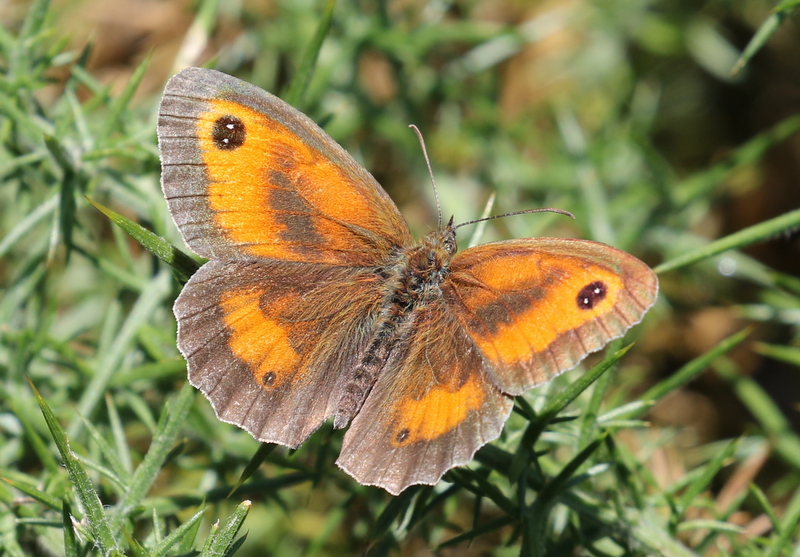 Gatekeeper – one of the commoner butterflies on the wing now
Gatekeeper – one of the commoner butterflies on the wing now
One of the specialities of the Heath is Silver-studded Blue. We are reaching the end of the flight season now, so many are looking a little tatty, but we did manage to find one slightly smarter male.
 Silver-studded Blue – the best we could find, they are getting rather worn now
Silver-studded Blue – the best we could find, they are getting rather worn now
We came across several Yellowhammers and plenty of Linnets as we walked. Rounding a corner, we could just hear a Dartford Warbler calling from somewhere on the other side of a large mound of gorse. We walked quietly round and stood listening, and after a few seconds the Dartford Warbler shot out from the gorse in front of us and disappeared out of view. We followed in the direction it had gone, and came across a family of Stonechats, a pair with at least three streaky juveniles. We could hear the rather wren-like begging calls of the youngsters as we approached, followed by the alarm calls of the adults.
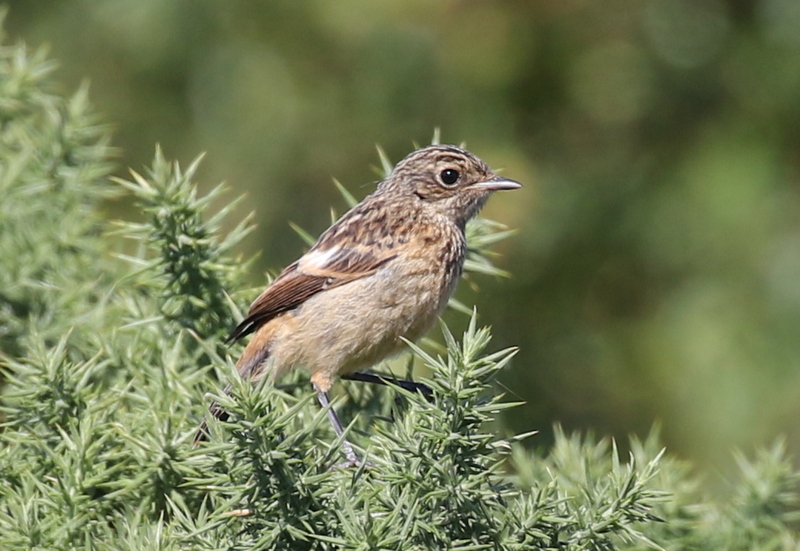 Stonechat – one of the streaky juveniles
Stonechat – one of the streaky juveniles
The family of Stonechats are very mobile now, so we tried to follow them as they moved about the heath. As they did so, it became clear that a small, dark, long-tailed bird was following after them – a Dartford Warbler. It was keeping down low in the heather or flying across between patches of vegetation, but we couldn’t get close to it as it followed the Stonechats just out of range or disappeared into the tall gorse or trees out of view.
 Dartford Warbler – can you see me?
Dartford Warbler – can you see me?
A second Dartford Warbler appeared, and it too was keeping with the Stonechats. By quietly following them, we eventually saw a Dartford Warbler fly up into an isolated patch of gorse next to a path. We crept round the back of it, and suddenly the Dartford Warbler hopped up onto a branch – unfortunately it did not result in the hoped for photo!
We decided to continue on round the heath to see what else we could find. It was getting hot now, quite a contrast to the weather this morning. On the more open stony paths we found several Graylings basking in the sun. Almost impossible to see against the ground, they flew up ahead of us as we walked and one landed right next to us again.
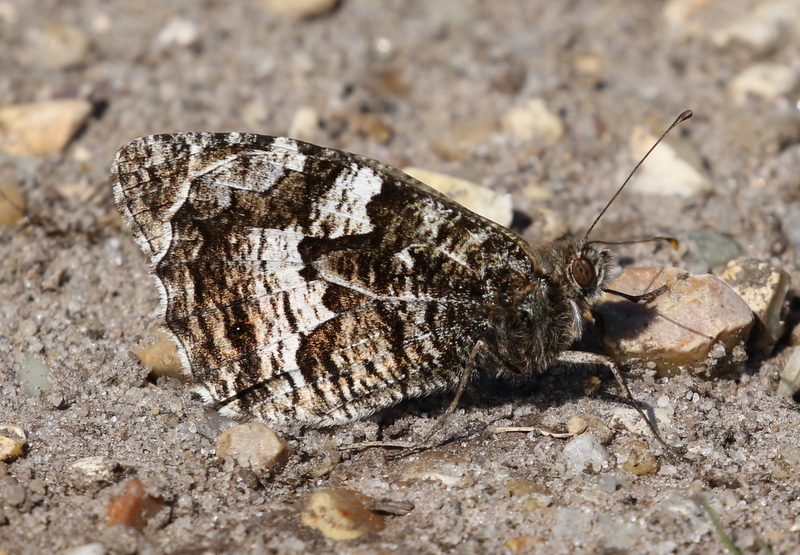 Grayling – well camouflaged against the stony ground
Grayling – well camouflaged against the stony ground
As well as being hot, it was getting quite disturbed now, with lots of people out enjoying the improvement in the weather, dog walkers and cyclists. We walked over to another area favoured by the Dartford Warblers, but there was no sign of any birds here today, although we didn’t linger very long. We decided to head back to the family of Stonechats to try our luck back their again.
 Stonechat – the male standing guard over the family
Stonechat – the male standing guard over the family
We found the Stonechats close to where we had left them and this time there appeared to be three Dartford Warblers with them. They all appeared to be juveniles – various shades of grey, lacking the vinous-red underparts of the adults. Once again, they were frustratingly difficult to see, low in the heather, apart from when they flew.
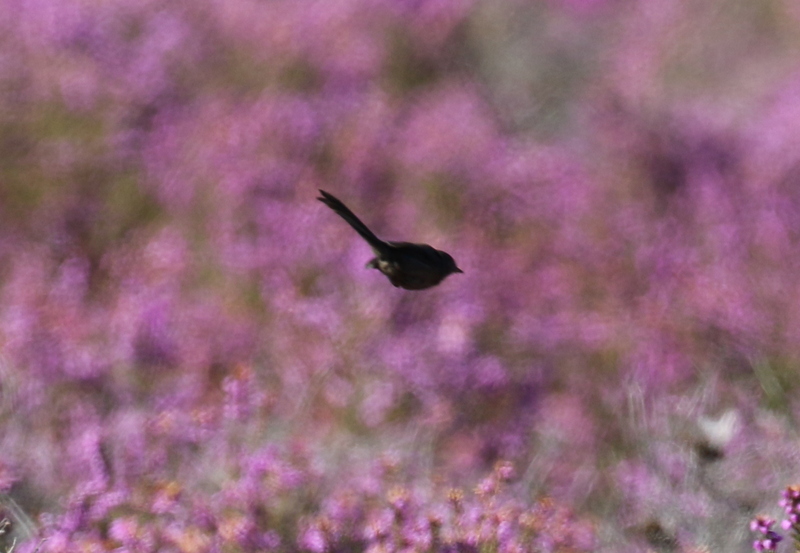 Dartford Warbler – a typical view, darting between clumps of heather
Dartford Warbler – a typical view, darting between clumps of heather
We had managed to get some distant images of a Dartford Warbler perched in a more open small oak tree, and decided to call it a day. As we turned to go, one of the Dartford Warblers flew up from the heather close to us and landed in a large clump of gorse nearby. As if to taunt us for its previous unhelpfulness, it then perched in the top for a few seconds!
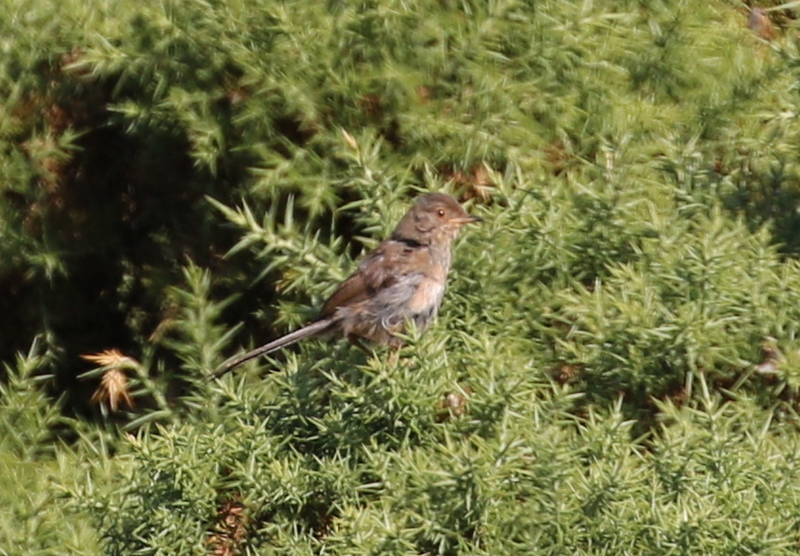 Dartford Warbler – finally one perched up for a few seconds
Dartford Warbler – finally one perched up for a few seconds
That seemed an appropriate way to end, so we headed back to the car.
















